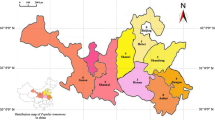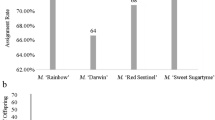Abstract
When hundreds of cross-pollinated trees planted in The National Gene Bank of Populus tomentosa blossom and bear fruit, in theory, half-sib progeny should originate from hundreds of combinations. Paternity testing was performed on the superior half-sib progeny with outstanding performance using microsatellite markers, a process that can be used to rapidly screen for superior cross combinations and significantly improve the efficiency and effectiveness of genetic improvements. Based on the comprehensive evaluation of the eight main growth traits of 2292 plants of 30 half-sib families, 77 plants consisting of 43 triploid and 34 diploid plants were selected as superior. We used 14 pairs of highly polymorphic SSR primers to identify the male parents of the 77 superior plants. Our results identified 29 male trees as the pollen parents of 59 superior plants from 49 cross combinations. The probabilities of 2-14, 3-48-1, 1903, 2-1, 4234, 5099, and 4114 as male parents were significantly higher than those of other males, suggesting that these male parents have potential for applications in breeding strategies of P. tomentosa. Thus, this study used SSR molecular markers to identify the male parents of superior individuals in a P. tomentosa population, laying a foundation for the application of maternal efficiency and construction of optimal hybrid parent groups.



Similar content being viewed by others
References
Baruca Arbeiter A, Jakse J, Bandelj D (2014) Paternity analysis of the olive variety “Istrska belica” and identification of pollen donors by microsatellite markers. ScientificWorldJournal 2014:208590–208596. https://doi.org/10.1155/2014/208590
Bai FY (2015) Evaluation of elite tree resource and construction of parent population for breeding program in Populus tomentosa Carr. Dissertation, Beijing: Beijing Forestry University (in chinese)
Chaib J, Devaux MF, Grotte MG, Robini K, Causse M, Lahaye M, Marty I (2007) Physiological relationships among physical, sensory, and morphological attributes of texture in tomato fruits. J Exp Bot 58(8):1915–1925. https://doi.org/10.1093/jxb/erm046
Dangl GS, Yang J, Golino DA, Gradziel T (2009) A practical method for almond cultivar identification and parental analysis using simple sequence repeat markers. Euphytica 168(1):41–48. https://doi.org/10.1007/s10681-008-9877-0
Dong CB, Suo YJ, Kang XY (2014a) Assessment of the genetic composition of triploid hybrid Populus using SSR markers with low recombination frequencies. Can J For Res 44(7):692–699. https://doi.org/10.1139/cjfr-2013-0360
Dong CB, Mao JF, Suo YJ, Shi L, Wang J, Zhang PD, Kang XY (2014b) A strategy for characterization of persistent heteroduplex DNA in higher plants. Plant J 80(2):282–291. https://doi.org/10.1111/tpj.12631
Eckenwalder JE (1996) Systematics and evolution of Populus. Biology of Populus and its Implications for Management and Conservation 7:30
El-Kassaby YA, Cappa EP, Liewlaksaneeyanawin C, Kla´psˇteˇ J, Lstibu°rek M (2011) Breeding without Breeding: Is a Complete Pedigree Necessary for Efficient Breeding? PLoS ONE 6(10): e25737. https://10.1371/journal.pone.0025737
El-Kassaby YA, Lindgren D (2007) Increasing the efficiency of breeding without breeding through phenotypic pre-selection in open pollinated plants. In: Joint meeting of the South. For. tree improve. conf. and the Western for. genetics association. Galveston, Texas, pp 15–19
El-Kassaby YA, LstibŮRek M (2009) Breeding without breeding. Genet Res 91(02):111–120. https://doi.org/10.1017/s0016672309 00007x
Every AD, Wiens D (1971) Triploidy in Utah Aspen. Madrono 21(3):138–147
Galbraith DW, Harkins KR, Maddox JM, Ayres NM, Sharma DP, Firoozabady E (1983) Rapid flow cytometric analysis of the cell cycle in intact plant tissues. Science (New York, NY) 220(4601):1049–1051. https://doi.org/10.1126/science.220.4601.1049
Hamant O, Ma H, Cande WZ (2006) Genetics of meiotic prophase I in plants. Annu Rev Plant Biol 57(1):267–302. https://doi.org/10.1146/annurev.arplant.57.032905.105255
Hulce D, Li X, Snyderleiby T, Johathan Liu CS (2011) GeneMarker® Genotyping Software: tools to increase the statistical power of DNA fragment analysis. J Biomolr Tech Jbt 22(Suppl):S35–S36
Isagi Y, Kanazashi T, Suzuki W, Tanaka H, Abe T (2004) Highly variable pollination patterns in Magnolia obovata revealed by microsatellite paternity analysis. Int J Plant Sci 165(6):1047–1053. https://doi.org/10.1086/423883
Jones AG, Small CM, Paczolt KA, Ratterman NL (2010) A practical guide to methods of parentage analysis. Mol Ecol Resour 10(1):6–30. https://doi.org/10.1111/j.1755-0998.2009.02778.x
Kang XY, Zhu ZT, Zhang ZY (1997) Study on natural triploid of Populus tomentosa and its origin. In: The fourth annual meeting of forest genetics and breeding. Guilin, Guangxi, China, p2 (in chinese)
Kang XY, Zhu ZT, Lin HB (1999) Study on the effective treating period for pollen chromosome doubling of Populus tomentosa × P. bolleana. Scientia Silvae Sinicae 35(04):22–25 (in chinese)
Kang XY, Zhu ZT, Zhang ZY (2000) Breeding of triploids by the reciprocal crossing of Populus alba×P. glandulosa and P. tomentosa×P. bolleana. J Beijing For Univ 22(6):8–11 (in chinese)
Kang XY (2002) Cytogenetics and selection of triploids of Populus tomentosa. Beijing: China Environmental Sciences Press (in chinese)
Kang XY, Zhang PD, Gao P, Zhao F (2004) Discovery of a new way of poplar triploids induced with colchicine after pollination. Journal of Beijing Forestry University 26(1):1–4 (in chinese)
Li TQ, Zhu ZT (1989) Study on the difficulty degree and way of hybridizationdegree in Populus tomentosa Carr. J Beijing For Univ 11(3):54–59 (in chinese)
Li Y, Zhu ZT, Tian YT, Zhang ZY, Kang XY (2000) Obtaining triploids by high and low temperature treating female flower buds of white poplar. J Beijing For Univ 22(5):7–12 (in chinese)
Landergott U, Naciri Y, Schneller JJ, Holderegger R (2006) Allelic configuration and polysomic inheritance of highly variable microsatellites in tetraploid gynodioecious Thymus praecox agg. Theor Appl Genet 113(3):453–465. https://doi.org/10.1007/s00122-006-0310-6
Loureiro J, Rodriguez E, Dolezel J, Santos C (2007) Two new nuclear isolation buffers for plant DNA flow cytometry: a test with 37 species. Ann Bot-London 100(4):875–888. https://doi.org/10.1093/annbot/mcm152
Li YH, Kang XY (2007) Triploid induction in white poplar by chromosome doubling of megaspore. J Beijing For Univ 29(5):22–25 (in chinese)
Müntzing A (1936) The chromosomes of a giant Populus Tremula. Hereditas 21(2–3):383–393
Marshall TC, Slate J, Kruuk LEB, Pemberton JM (1998) Statistical confidence for likelihood-based paternity inference in natural populations. Mol Ecol 7(5):639–655. https://doi.org/10.1046/j.1365-294x.1998.00374.x
Moriya S, Iwanami H, Okada K, Yamamoto T, Abe K (2011) A practical method for apple cultivar identification and parent-offspring analysis using simple sequence repeat markers. Euphytica 177(1):135–150. https://doi.org/10.1007/s10681-010-0295-8
Naito Y, Kanzaki M, Iwata H, Obayashi K, Lee SL, Muhammad N, Okuda T, Tsumura Y (2008) Density-dependent selfing and its effects on seed performance in a tropical canopy tree species, Shorea acuminata (Dipterocarpaceae). Forest Ecol Manag 256(3):375–383. https://doi.org/10.1016/j.foreco.2008.04.031
Nilsson-Ehle H (1936) Über Eine in der Natur Gefundene Gigasform von Populus Tremula. Hereditas 21(21):379–382
Pestana M, Beja P, Correia PJ, De VA, Faria EA (2005) Relationships between nutrient composition of flowers and fruit quality in orange trees grown in calcareous soil. Tree Physiol 25(6):761–767. https://doi.org/10.1093/treephys/25.6.761
Pollegioni P, Woeste K, Mugnozza GS, Malvolti ME (2009) Retrospective identification of hybridogenic walnut plants by SSR fingerprinting and parentage analysis. Mol Breed 24(4):321–335. https://doi.org/10.1007/s11032-009-9294-7
Robledo-Arnuncio JJ, Gil L (2005) Patterns of pollen dispersal in a small population of Pinus sylvestris L. revealed by total-exclusion paternity analysis. Heredity (Edinb) 94(1):13–22. https://doi.org/10.1038/sj.hdy.6800542
Schuelke M (2000) An economic method for the fluorescent labeling of PCR fragments. Nat Biotechnol 18(2):233–234. https://doi.org/10.1038/72708
Streiff D, Lexer S, Gloessl K (1999) Pollen dispersal inferred from paternity analysis in a mixed oak stand of Quercus robur L. and Q. petraea (Matt.) Liebl. Mol Ecol 8(5):831–841. https://doi.org/10.1046/j.1365-294X.1999.00637.x
Swisher LL, Beckstead JW, Bebeau MJ (2004) Factor analysis as a tool for survey analysis using a professional role orientation inventory as an example. Phys Ther 84(9):784–799
Tabbener HE, Cottrell JE (2003) The use of PCR based DNA markers to study the paternity of poplar seedlings. Forest Ecol Manag 179(1–3):363–376. https://doi.org/10.1016/S0378-1127(02)00538-8
Tamm YA, Yarvekyulg LY (1975) Results of searches for triploid aspen in Estonia. Lesovedenie 6:19–26
Van Eenennaam AL, Weaber RL, Drake DJ, Penedo MC, Quaas RL, Garrick DJ, Pollak EJ (2007) DNA-based paternity analysis and genetic evaluation in a large, commercial cattle ranch setting. J Anim Sci 85(12):3159–3169. https://doi.org/10.2527/jas.2007-0284
Vanbuijtenen JP, Einspahr PN, Einspahr DW (1958) Naturally occurring triploid Quaking Aspen [Populus tremuloides] in the United States. Int J Eng Educ 23(4):735–740
Wang X-R, Torimaru T, Lindgren D, Fries A (2009) Marker-based parentage analysis facilitates low input ‘breeding without breeding’ strategies for forest trees. Tree Genet Genomes 6(2):227–235. https://doi.org/10.1007/s11295-009-0243-8
Wang DS (2016) Molecular phylogeny of section Leuce and the hybridization origin of hybrids in section Leuce of Populus. Chinese Academy of Forestry, Doctor, Beijing (in chinese)
Zhu DB (1990) Research on the reproduction capacity of Populus tomentosa. J Beijing For Univ 12(1):1–9 (in chinese)
Zhang ZY, Li FL (1992) Studies on chromosome doubling and triploid breeding of white poplar(I): the techniques of the pollen chromosome doubling. J Beijing For Univ S3:52–58 (in chinese)
Zhu ZT, Lin HB, Kang XY (1995) Studies on allotriploid breeding of Populus tomentosa B301 clones[J]. Sci Silvae Sin 31(6):499–505+579 (in chinese)
Zhu ZT, Kang XY, Zhang ZY (1998) Studies on selection of natural triploids of Populus tomentosa. Scientia Silvae Sinicae 34(4):24–33 (in chinese)
Zhu ZT (2006) Genetic improvement of Populus tomentosa Carr. China Forestry Publishing House, Beijing (in chinese)
Acknowledgments
The authors would like to thank the staff of Guanxian nursery in Shandong Province, China, for providing their experimental field. We were also grateful to the anonymous reviewers and editors for their constructive comments. This work was supported by National Natural Science Foundation of China (31530012): The Program of the Co-Construction with Beijing Municipal Commission of Education of China.
Author information
Authors and Affiliations
Corresponding author
Ethics declarations
Conflict of interest
The authors declare that they have no conflict of interest.
Ethical standards
The experiments reported in this study comply with the current laws of China.
Electronic supplementary material
ESM 1
(DOCX 419 kb)
Rights and permissions
About this article
Cite this article
Han, Z., Gao, P., Geng, X. et al. Identification of the male parent of superior half-sib Populus tomentosa individuals based on SSR markers. Mol Breeding 37, 155 (2017). https://doi.org/10.1007/s11032-017-0754-1
Received:
Accepted:
Published:
DOI: https://doi.org/10.1007/s11032-017-0754-1




